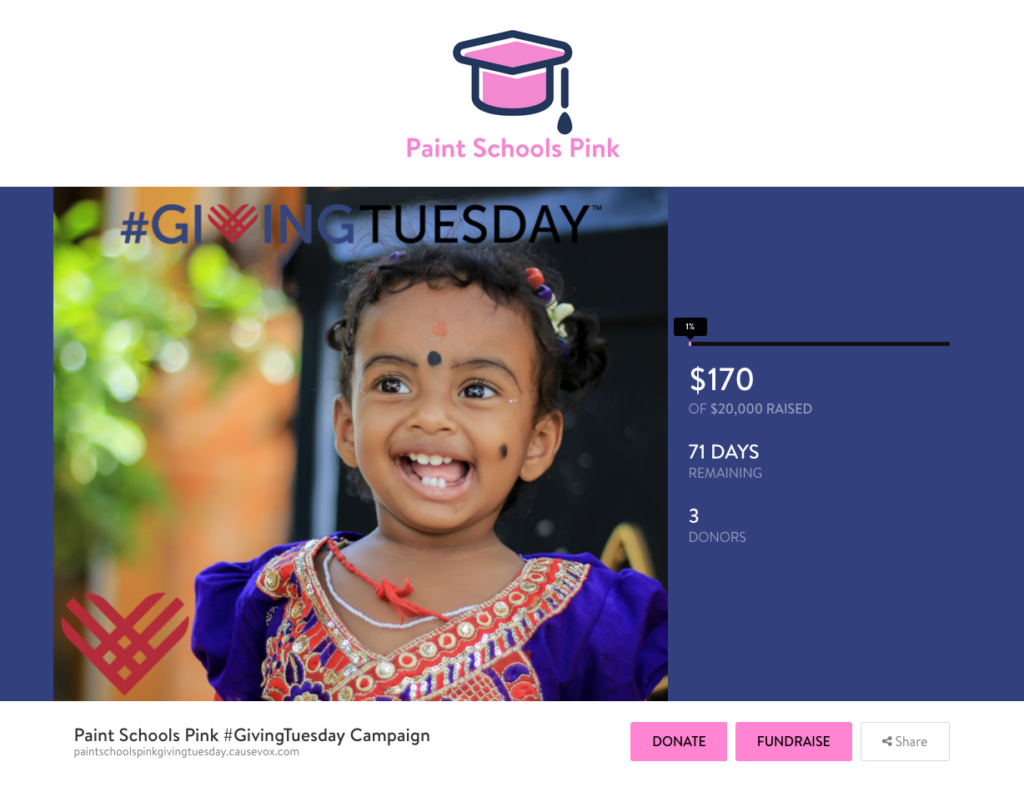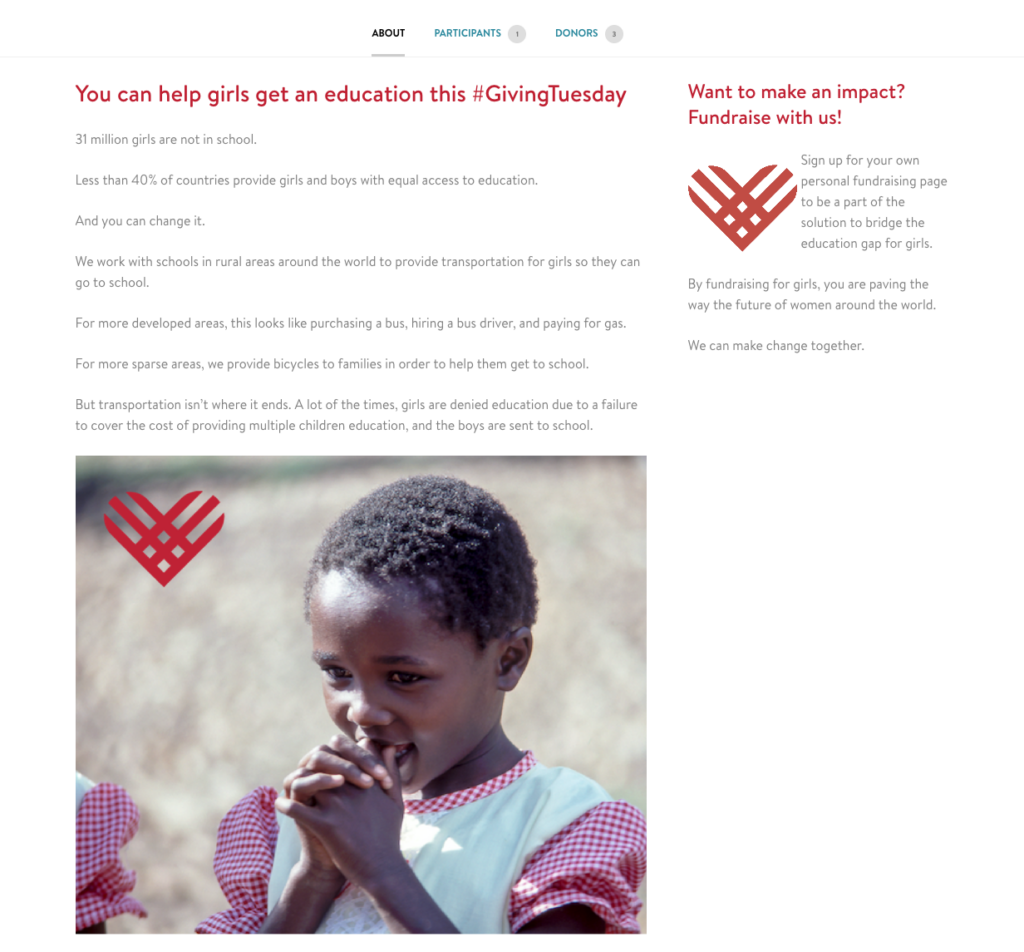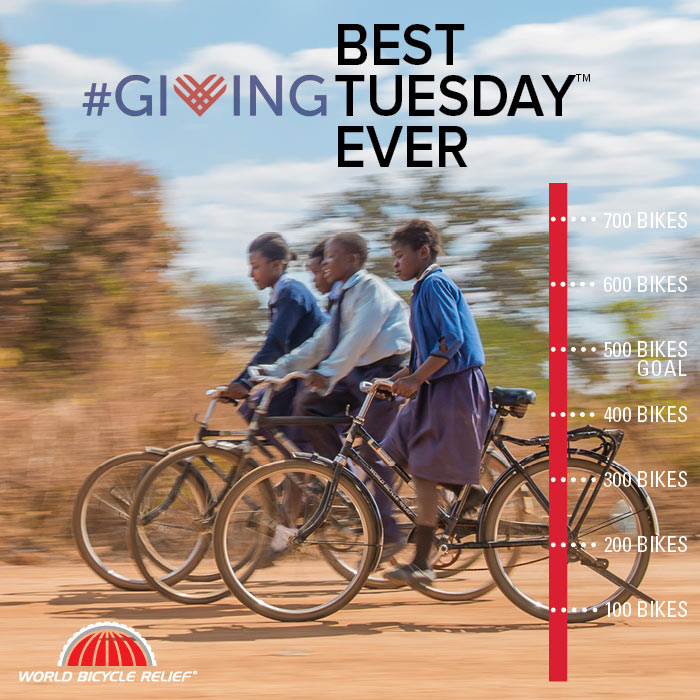#GivingTuesday is a global day of giving, on the Tuesday following Thanksgiving, after the crazy shopping on Black Friday and Cyber Monday have come to a close.
#GivingTuesday is perfectly positioned, as it rests at the beginning of the giving season, just as people are getting into the holiday spirit.
Last year, over $177 million was raised on #GivingTuesday, from over 1.6m donors.
This year, #GivingTuesday lands on November 28th, which is fast approaching, and you can tap into this opportunity.
I’ve gotten a chance to see two #GivingTuesdays here at CauseVox, and have personally helped hundreds of nonprofits create their #GivingTuesday campaign. During this time, I saw firsthand what makes a #GivingTuesday campaign stand out above the rest.
And I want to share those key learnings with you.
#GivingTuesday is always an exciting time, but what’s truly exciting is to see so many nonprofits try it out for the first time and be successful.
Download your #GivingTuesday planning guide
[amp-optin id=24996]
So what does it take to create a successful #GivingTuesday campaign on CauseVox?
Here’s 5 things every successful #GivingTuesday campaign on CauseVox has in common.
“Here’s 5 things every successful #GivingTuesday campaign on CauseVox has in common.” tweet this
1) They Start Early
As with every good campaign, a great #GivingTuesday campaign starts with a bit of preparation, and that doesn’t just look like getting your campaign site ready (although that is a part of it).
Starting preparations early really looks like educating yourself on #GivingTuesday and best practices, nailing down your goals, securing partnerships and matching gifts, creating and executing a communications calendar, and more.
Starting your campaign preparations now will allow you more time to get everything in place that you need to succeed.
For a detailed timeline that can help you stay on track and prepare ahead of time, view our Ideal #GivingTuesday Fundraising Campaign Timeline.
If you’re looking for an in depth resource to help guide you through the #GivingTuesday campaign preparation process, join our webinar on How To Plan A Successful #GivingTuesday Fundraising Campaign
2) They Co-Brand Their Campaign Site
Previously, I’ve written about the importance of designing your site to fit in with your nonprofit’s branding. In short, this helps your donors recognize the site as belonging to you, and even makes it easier to interact with so that more people give.
And branding is never more important than with a #GivingTuesday campaign, but this time around, you’ll want to co-brand the site.
“Branding is never more important than with a #GivingTuesday campaign.” tweet this
This means you’ll want to put your own images and colors on the site, as well as #GivingTuesday logos and images, so that the second they land on the page they know why they’re receiving this donation ask on November 28th, without needing to read the fine print.
Here’s a look at the logo Texas Public radio uploaded on their campaign site:

When creating your #GivingTuesday campaign, be sure to incorporate #GivingTuesday into the look and feel of your campaign, along with your own branding.
Here’s this year’s logos you can download straight from the GivingTuesday site that you can use on your site and in your promotional materials.
Once you have your logos, consider using a tool like Canva to easily place the #GivingTuesday logos over different images used on your campaign site.

In addition, the hex color codes #C02032 (red) and #32417E (blue) are used in the #GivingTuesday logo, and can be incorporated on your campaign site, such as for your buttons, stats background, or more for an even further branded look.
Here’s how I would design a #GivingTuesday campaign for my Paint Schools Pink campaign example.


By using a mix of my own nonprofit example’s colors and pictures, as well as the #GivingTuesday colors and careful placement of logos, the campaign looks specially designed for the day of giving, and it all only took about 15 minutes to do.
This helps your audience see that your campaign is connected with something bigger than your organization, and lets your donors know right away how #GivingTuesday is driving your campaign.
3) (Nearly) Every One Of Them Use #GivingTuesday To Kick Off Their Year-End Campaign
#GivingTuesday is powerful on it’s own, no doubt, but #GivingTuesday combined with a year-end campaign? The results are unbelieveable.
If you’re doing #GivingTuesday right, you’ll be sending out emails and posting on social media a few weeks prior to November 28th to get your audience primed to give. With so much build up for a single day campaign, by rolling out your site afterward as a year-end campaign, you’ve already sparked the momentum needed to continue driving donations through year-end.
Starting your campaign off on #GivingTuesday will drive a huge spike in donations, help donations roll in throughout the giving season, and just as donations might have started to taper off- it’ll be the last 3 days of the year, which are known to account for about 12% of all donations your nonprofit will receive all year.
With your campaign starting and ending on high volume giving days, the momentum and support behind the campaign can really help you raise more.
Almost every #GivingTuesday campaign I’ve seen that really blew it out of the water did this, including the campaigns run by World Bicycle Relief, Foothill-De Anza Foundation, National Domestic Violence Hotline, and more.
Find out more about incorporating #GivingTuesday into your year-end campaign.
4) They Have An Impact Goal Tied To Their Fundraising Goal
It’s always important to have goals set for your campaign, but it is essential for #GivingTuesday.
Why? Because #GivingTuesday is at it’s core a flash fundraiser, which is a type of challenge. From the donor’s perspective, when they see your campaign goal up on your page, they’re challenged to reach that goal in an incredibly short time frame.
Without a defined fundraising goal, #GivingTuesday is just another nice thing they participate in, so the goal is actually a motivating factor for donors to give.
But here’s the thing, an arbitrary goal can only go so far. “Let’s see if we can raise $5,000 on #GivingTuesday,” is a good idea, but “Let’s raise $5000 on #GivingTuesday to provide 1000 coats to the homeless,” is an even better one.
At the end of the day, people are motivated to give because of the impact that it creates, so when you’re able to tie your fundraising goal to a specific impact goal, it helps you raise more.
Here’s an example of how World Bicycle Relief tied their #GivingTuesday goal in with their impact goal:

When your #GivingTuesday campaign revolves not just around funds raised, but also the people that are being helped through this campaign, the true heart behind #GivingTuesday shines through and people will be more excited to give and make an impact.
5) They Make Frequent Updates & Report Impact
With short campaign time frames come great responsibility…to communicate.
When #GivingTuesday comes, you’ll have 24 hours to make sure everyone on your subscriber list, donors, and followers on social media are informed about your campaign, are asked to give, and are updated on where you are in the process of meeting your goal.
This means that on the day of your campaign, you’ll want to send at least one email (I’d actually recommend two- one at the start and one towards the end of your campaign), a few blog posts on the campaign site, and a number of posts on social media.
But these emails and posts shouldn’t just be quantitative, they should be qualitative, too.
Here’s a few topics you’ll want to cover in your emails, blog, and social media posts throughout #GivingTuesday:
- Countdown: Hours left to reach your goal.
- Impact: How much impact your donors have made possible so far.
- Asks: How much you still need to reach your impact/fundraising goals.
- Educational: Sharing relevant statistics to inform your community.
- Stories: The stories of your donors, fundraisers, and/or the people this campaign is impacting. These are really important for the emotional connection for your campaign.
- Share requests: Asking your community to share their own #MyGivingStory. This ups your audience participation and ownership over #GivingTuesday.
- Thank yous to individuals and your community as a whole for their participation.
As a best practice, don’t forget to share powerful images and video along with these that help you stand out on #GivingTuesday.
If you cover each of these topics in your various communications, you’ll be sure to keep your audience engaged in your campaign on a personal level, so that they too are rooting for you to succeed. And when you do, let them know!
When #GivingTuesday comes to a close, communicate back to your audience the amount raised and the impact they created, and celebrate the donors for getting you there.
Getting Your #GivingTuesday Campaign Ready
Are you ready to get started with your own #GivingTuesday campaign?
“Are you ready to get started with your own #GivingTuesday campaign?” tweet this
If you’re already a CauseVox user, our success team is here to help. Shoot us an email at support@causevox.com and we can get you set up for a campaign consultation with our success team.
Not yet a user? Sign up for a 1-1 demo to see how CauseVox can help your #GivingTuesday campaign succeed.
If you liked this post, you may also like:
- #GivingTuesday 2017 Ideas & Best Practices
- The Ideal #GivingTuesday Fundraising Campaign Timeline
- #GivingTuesday 2017: How To Plan A Successful Fundraising Campaign
Raise More With Less Effort on #GivingTuesday
Don’t let clunky technology keep you from reaching your #GivingTuesday fundraising goals.
You can create a #GivingTuesday campaign that you and your donors will love, helping you raise more with less stress and frustration.
Plus, you’ll save tons of time on administrative tasks and data management, so you have more time to invest in your fundraising strategy.




